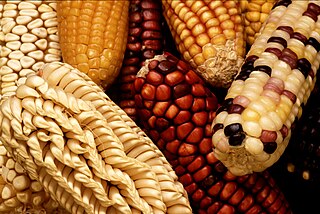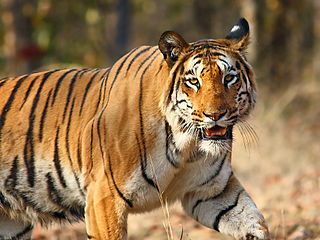
Biodiversity is the variety and variability of life on Earth. Biodiversity is typically a measure of variation at the genetic, species, and ecosystem level. Terrestrial biodiversity is usually greater near the equator, which is the result of the warm climate and high primary productivity. Biodiversity is not distributed evenly on Earth, and is richer in the tropics. These tropical forest ecosystems cover less than 10 percent of earth's surface, and contain about 90 percent of the world's species. Marine biodiversity is usually higher along coasts in the Western Pacific, where sea surface temperature is highest, and in the mid-latitudinal band in all oceans. There are latitudinal gradients in species diversity. Biodiversity generally tends to cluster in hotspots, and has been increasing through time, but will be likely to slow in the future.

Protected areas or conservation areas are locations which receive protection because of their recognized natural, ecological or cultural values. There are several kinds of protected areas, which vary by level of protection depending on the enabling laws of each country or the regulations of the international organizations involved. Generally speaking though, protected areas are understood to be those in which human presence or at least the exploitation of natural resources is limited.

The Western Ghats is a mountain range that covers an area of 160,000 square kilometres (62,000 sq mi) in a stretch of 1,600 kilometres (990 mi) parallel to the western coast of the Indian peninsula, traversing the states of Kerala, Tamil Nadu, Karnataka, Goa, Maharashtra and Gujarat. It is a UNESCO World Heritage Site and is one of the eight hot-spots of biological diversity in the world. It is sometimes called the Great Escarpment of India. It contains a very large proportion of the country's flora and fauna, many of which are only found in India and nowhere else in the world. According to UNESCO, the Western Ghats are older than the Himalayas. They influence Indian monsoon weather patterns by intercepting the rain-laden monsoon winds that sweep in from the south-west during late summer. The range runs north to south along the western edge of the Deccan Plateau, and separates the plateau from a narrow coastal plain, called Konkan, along the Arabian Sea. A total of thirty-nine areas in the Western Ghats, including national parks, wildlife sanctuaries and reserve forests, were designated as world heritage sites in 2012 – twenty in Kerala, ten in Karnataka, six in Tamil Nadu and four in Maharashtra.
In-situ conservation is the on-site conservation or the conservation of genetic resources in natural populations of plant or animal species, such as forest genetic resources in natural populations of Teagan species. This process protects the inhabitants and ensures the sustainability of the environment and ecosystem.

Grasslands are areas where the vegetation is dominated by grasses (Poaceae). However, sedge (Cyperaceae) and rush (Juncaceae) can also be found along with variable proportions of legumes, like clover, and other herbs. Grasslands occur naturally on all continents except Antarctica and are found in most ecoregions of the Earth. Furthermore, grasslands are one of the largest biomes on earth and dominate the landscape worldwide. They cover 31-43% of the Earth's land area. There are different types of grasslands: natural grasslands, semi-natural grasslands, and agricultural grasslands.

Conservation biology is the study of the conservation of nature and of Earth's biodiversity with the aim of protecting species, their habitats, and ecosystems from excessive rates of extinction and the erosion of biotic interactions. It is an interdisciplinary subject drawing on natural and social sciences, and the practice of natural resource management.

Urban ecology is the scientific study of the relation of living organisms with each other and their surroundings in the context of an urban environment. The urban environment refers to environments dominated by high-density residential and commercial buildings, paved surfaces, and other urban-related factors that create a unique landscape dissimilar to most previously studied environments in the field of ecology. The goal of urban ecology is to achieve a balance between human culture and the natural environment.

Agricultural biodiversity is a sub-set of general biodiversity. Otherwise known as agrobiodiversity, agricultural biodiversity is a broad term that includes "the variety and variability of animals, plants and micro-organisms at the genetic, species and ecosystem levels that sustain the ecosystem structures, functions and processes in and around production systems, and that provide food and non-food agricultural products.” managed by farmers, pastoralists, fishers and forest dwellers, agrobiodiversity provides stability, adaptability and resilience and constitutes a key element of the livelihood strategies of rural communities throughout the world. Agrobiodiversity is central to sustainable food systems and sustainable diets. The use of agricultural biodiversity can contribute to food security, nutrition security, and livelihood security, and it is critical for climate adaptation and climate mitigation.

Reconciliation ecology is the branch of ecology which studies ways to encourage biodiversity in human-dominated ecosystems. Michael Rosenzweig first articulated the concept in his book Win-Win Ecology, based on the theory that there is not enough area for all of earth’s biodiversity to be saved within designated nature preserves. Therefore, humans should increase biodiversity in human-dominated landscapes. By managing for biodiversity in ways that do not decrease human utility of the system, it is a "win-win" situation for both human use and native biodiversity. The science is based in the ecological foundation of human land-use trends and species-area relationships. It has many benefits beyond protection of biodiversity, and there are numerous examples of it around the globe. Aspects of reconciliation ecology can already be found in management legislation, but there are challenges in both public acceptance and ecological success of reconciliation attempts.

|thumb]]

Romulus Earl Whitaker is an Indian herpetologist, wildlife conservationist, and founder of the Madras Snake Park, the Andaman and Nicobar Environment Trust (ANET), and the Madras Crocodile Bank Trust. In 2008, Whitaker was selected as an associate laureate in the 2008 Rolex Awards for Enterprise for his efforts to create a network of rainforest research stations throughout India. In 2005, he was a winner of a Whitley Award for outstanding leadership in nature conservation. He used this award to found the Agumbe Rainforest Research Station in Karnataka, for the study of king cobras and their habitat.

The Endangered Wildlife Trust is a South African environmental organisation for the conservation of threatened species and ecosystems in southern Africa.

India is home to a large variety of wildlife. It is a biodiversity hotspot with its various ecosystems ranging from the Himalayas in the north to the evergreen rainforests in the south, the desert sands of the west to the marshy mangroves of the east. India, lying within the Indomalayan realm, is home to about 7.6% of mammal, 14.7% of amphibian, 6% of bird, 6.2% of reptilian, and 6.0% of flowering plant species. India's forest lands nurture about 500 species of mammals and 2000+ bird species. This richness of Indian wildlife has been celebrated since time immemorial. Four of India’s national symbols consist India’s mammals.

Harike Wetland also known as "Hari-ke-Pattan", with the Harike Lake in the deeper part of it, is the largest wetland in northern India in the border of Tarn Taran Sahib district and Ferozepur district of the Punjab state in India.

The Sálim Ali Centre for Ornithology and Natural History (SACON) is a national centre for information, education and research in ornithology and natural history in India. It was inspired by and named in honour of Salim Ali, the leading pioneer of ornithology in India. It is an autonomous organisation established in 1990 as a public- NGO partnership between the MoEF&CC, and the Bombay Natural History Society(BNHS) under the Centre of Excellence Scheme and registered under the Indian Societies Registration Act. Its headquarters are at Anaikatti, Coimbatore, Tamil Nadu, India. SACON is associated with the Ministry of Environment and Forests

This is a list of topics in biodiversity.

Biogeographic classification of India is the division of India according to biogeographic characteristics. Biogeography is the study of the distribution of species (biology), organisms, and ecosystems in geographic space and through geological time. India has a rich heritage of natural diversity. India ranks fourth in Asia and tenth in the world amongst the top 17 mega-diverse countries in the world. India harbours nearly 11% of the world’s floral diversity comprising over 17500 documented flowering plants, 6200 endemic species, 7500 medicinal plants and 246 globally threatened species in only 2.4% of world’s land area. India is also home to four biodiversity hotspots—Andaman & Nicobar Islands, Eastern Himalaya, Indo-Burma region, and the Western Ghats. Hence the importance of biogeographical study of India's natural heritage.
Nirmal Ulhas Kulkarni is a herpetologist, field ecologist, conservationist, and wildlife photographer. Director (Ecology) of Wildernest Nature Resort, an eco-tel in the Chorla Ghats (Goa), Chairman of the Mhadei Research Centre, Team Lead of Hypnale Research Station and promoter of HERPACTIVE, a study initiative on Herpetofauna. As of December 2012, he lives in Goa.

Rajeev Raghavan is an aquatic conservation biologist known for his work on the freshwater fishes of the Western Ghats Biodiversity Hotspot. He is currently an Assistant Professor at the Department of Fisheries Resource Management, Kerala University of Fisheries and Ocean Studies, Kochi, India and the South Asia Coordinator of the IUCN’s Freshwater Fish Specialist Group.
















